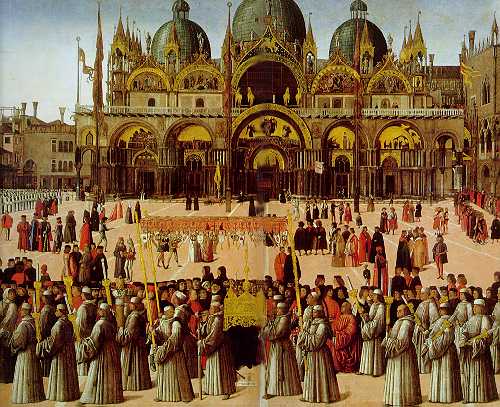
To ask such questions is not, of course, to presuppose uniformity of experience; a woodworker living in Cannaregio, a member of his guild and of the congregation of his parish church, perhaps an infrequent visitor to the Piazza Grande, would have been exposed to quite different re-inforcements of his sense of 'Venetian-ness' than a member of the nobility living on the Grand Canal. 'Being Venetian' in the sixteenth and seventeenth centuries was clearly not such a monochromatic or unified state of mind as the official historiographers and the patrician proponents of the 'Myth of Venice' would have liked posterity to believe; on the contrary, even within the community of native Venetians living in this, the most cosmopolitan city in Europe, the details of individual experiences of liturgy and ceremony varied greatly according to class and occupation, guild membership and parish affiliation. Nor can it be assumed that individual attachment to the Venetian polity was identical. Indeed, what is sometimes described as wholesale societal attachment to the ideals of the 'Myth of Venice', that vision of the city as the perfect state expressed and re-enacted in spectacular ceremonial acts, may also have functioned as a way of asserting some measure of patrician control over the population of a city which certainly contained heretical and dissenting elements. (1) Yet while ceremonial expressions of Venetian superiority may well have impressed plebeian spectators, it is harder to credit them with disciplining relcalcitrant members of the patriciate or successfully instructing sophisticated foreign visitors in the niceties of the Venetian constitution as is sometimes suggested. Indeed, we should remember that Venetian civic ritual was not necessarily designed purely for the local population alone. As the experiences of pilgrims show, foreign visitors, a significant ingredient in the Venetian social mix, were not only observers of Venetian ritual but could also be participants; this provided the Republic with yet further opportunities for propaganda. The Venetian celebration of the Feast of Corpus Christi is perhaps the most spectacular example of state appropriation of an event of universal spiritual significance so as to lend it a specifically Venetian stamp. On this occasion, pilgrims, or at least the more high-born of them, participated in the traditional procession around St. Mark's Square, much as in a similar event shown in Gentile Bellini's famous picture of 1496.

Gentile Bellini: Procession in St. Mark Square, 1496 (detail). Venice, Accademia.
Each, accompanied by a member of the Venetian patriciate, carried a candle which was subsequently placed in front of the Holy Sepulchre in Jerusalem, an experience noted by the fifteenth-century English pilgrim Sir Richard Guylforde who was among those who processed 'with lyghte in our handes of wexe, of the freshest formynge, geven unto us by the mynysters of the sayde procession'. (2) The result is characteristic of much Venetian ritual, transforming the universally Christian into the specifically Venetian and in the process appropriating a common processional form which could be witnessed throughout Catholic Europe by investing it with specific local significance. In this process the city of Venice became almost a psychological extension of the sacred space of Jerusalem itself, the ceremonies in the Piazza and in the Basilica in the presence of the Doge a form of official benediction of a great enterprise. (In later centuries, when the pilgrimage trade had effectively become a thing of the past, each member of the nobility accompanied a member of the Venetian poor who was presented on this occasion with clothing, money and a candle, the latter a symbolic remnant of the previous practice). The example of the Corpus Christi procession reminds us that while the motivations for Venetian civic and religious rituals were complex and interlocking, the 'audience' for them was certainly not uniform but in effect expanded and contracted for different occasions. Pilgrims were in turn one of the vehicles through which the fame of Venice was widely disseminated abroad, particularly after printing made possible the publication of their accounts which often included detailed descriptions of the wonders of the city, sometime illustrated. Bernhard von Breydenbach's Peregrinationes (1496), with its well-known perspective view of Venice, is one of the earliest and most elegant examples of an extensive body of published travel accounts, maps and guides that disseminated literary and visual images of Venice throughout Europe and even beyond in ever-increasing numbers.